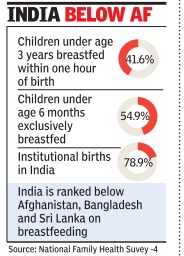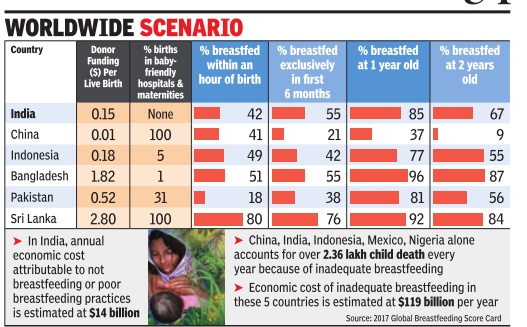Breastfeeding: India
(→Reasons for low breastfeeding level) |
|||
| Line 59: | Line 59: | ||
[http://epaperbeta.timesofindia.com/Article.aspx?eid=31808&articlexml=India-ranks-low-on-breastfeeding-practices-03082017008045 Sushmi Dey, India ranks low on breastfeeding practices, August 3, 2017: The Times of India] | [http://epaperbeta.timesofindia.com/Article.aspx?eid=31808&articlexml=India-ranks-low-on-breastfeeding-practices-03082017008045 Sushmi Dey, India ranks low on breastfeeding practices, August 3, 2017: The Times of India] | ||
| + | [[File: Breastfeeding level, 2017 , India and the world.jpg|Breastfeeding level, 2017, India and the world; [http://epaperbeta.timesofindia.com/Article.aspx?eid=31808&articlexml=India-ranks-low-on-breastfeeding-practices-03082017008045 Sushmi Dey, India ranks low on breastfeeding practices, August 3, 2017: The Times of India]|frame|500px]] | ||
India is among the world's five largest emerging economies where investment in breastfeeding is significantly low resulting in an annual economic loss of $14 billion because of child deaths and cognitive losses caused from poor breastfeeding practices, according to a report. | India is among the world's five largest emerging economies where investment in breastfeeding is significantly low resulting in an annual economic loss of $14 billion because of child deaths and cognitive losses caused from poor breastfeeding practices, according to a report. | ||
Revision as of 01:20, 4 August 2017
This is a collection of articles archived for the excellence of their content. Readers will be able to edit existing articles and post new articles directly |
Contents |
Breastfeeding and the law
From the archives of The Times of India 2007, 2009
‘Mother has right to breastfeed her child’
The Gujarat High Court has ordered Ahmedabad Civil Hospital to ensure that a woman breastfeeds her newborn girl, who was weaned away from her mother by her parents because she was a lovechild. When the court was told that the parents had forced the separation of the mother and child because they disapproved of her relationship with the child’s father, the court asked the hospital staff to take help of woman constables, if needed, to ensure that the parents did not interfere with their daughter’s life. Sarita — her parents claim that she was married — eloped with a Marathi boy, Hitesh, some time last year. Her parents filed a habeas corpus in the Gujarat high court and she was brought to the court by cops on July 27 last year. But she refused to go with her parents. The court told them Sarita was not a minor and was free to live with Hitesh. TNN From the archives of The Times of India 2007, 2009
Incidence
Only 44% newborns get mother’s milk

The Times of India, Sep 2, 2015
Himanshi Dhawan
Less than 50% are breastfed in first hour of birth in India
Despite increase in institutional deliveries, the number of children in India being breastfed in the first hour of birth is less than half.
India in fact ranks lowest among South Asian countries, including Afghanistan, Bangladesh and Sri Lanka in breastfeeding practices, with only 44% women being able to breastfeed their babies within one hour of delivery.
According to the World Breastfeeding Trends Initiative (WBTi) 2015, India scored 78 out of 150, only marginally higher than its 2012 score of 74. Paucity of data, ineffective policies, lack of budget and coordination, and absence of better monitoring are limiting breastfeeding practices in India.
Prepared by the Breastfeeding Promotion Network of India (BPNI) and the Public Health Resource Network (PHRN), the report indicates marginal improvement in Infant and Young Child Feeding (IYCF) practices. "It is not understandable why only 44% of women are able to begin breastfeeding within an hour when more than 75% of women deliver in institutions as claimed by PM Modi," Arun Gupta, BPNI central coordinator said. The report recommends an effective monitoring mechanism, national policy on IYCF, revival of baby-friendly hospitals, maternity protection and provision of a nine month maternity leave. The assessment, done every three to five years as part of WHO's World Breastfeeding Trends Initiative (WBTi), reveals gaps in all ten areas of policies and programmes to be implemented for enhancing breastfeeding rates.
According to the data, out of 26 million born in India, 14.5 million children are not able to get optimal feeding practices during the first year of life. While 44.6% women initiate breastfeeding within one hour of delivery, 64.9% are breastfed up to six months and 50.5% babies receive complementary food within 6-8 months.
The report said increasing sale of infant food, lack of support to women in the family and at workplaces and inadequate healthcare support as reasons behind low breastfeeding rate in the country.
41.6% children breastfed in first hour of birth

The pace of improvement in breastfeeding has been slow with less than half of children in India being breastfed in the first hour of birth, even as institutional deliveries have improved rapidly, accounting for almost 80% of all deliveries, data released from the fourth national family health survey (NFHS) shows.
The survey reveals that around 41.6% of children are being breastfed in the first hour of birth, up from 23.4% around 10 years ago.On the contrary , institutional deliveries have jumped from 38.7% to 78.9% between NFHS-3 and NFHS-4 -indicating an increase of over 40 percentage points. Exclusive breastfeeding among children under six months of age have also increased marginally in last 10 years from 46.4% to 54.9%, the new data shows.
Breastfeeding has dropped by around 10 percentage points in children of 6-8 months age after they start receiving semi solid food. Experts say India scores the lowest in breastfeeding practices among south Asian countries. “India needs a clear plan of action with budget allocations to scale up breastfeeding and infant and young child feeding indicators,“ said Arun Gupta, central coordinator for Breastfeeding Promotion Network of India.
Reasons for low breastfeeding level
2017/ Low level of investment in breastfeeding
Sushmi Dey, India ranks low on breastfeeding practices, August 3, 2017: The Times of India

India is among the world's five largest emerging economies where investment in breastfeeding is significantly low resulting in an annual economic loss of $14 billion because of child deaths and cognitive losses caused from poor breastfeeding practices, according to a report.
In India, less than 50% of children are breastfed within an hour of birth, whereas the rate of exclusive breastfeeding in the first six months stood at 55%. Early initiation of breastfeeding and exclusive breastfeeding can prevent nearly 99,499 deaths of children every year due to diarrhoea and pneumonia.
Five countries China, India, Indonesia, Mexico, Nigeria account for over 2,36,000 child deaths every year because of inadequate breastfeeding. These countries together incur an annual economic cost of $119 billion due to mortality and cognitive losses, says the report by UNICEF and WHO in collaboration with Global Breastfeeding Collective.
“We strongly recommend exclusive breastfeeding for the first six months. This protects children by providing them immunity against diseases and helps mothers reduce weight and chances of breast cancer,“ says Dr Indu Taneja, senior consultant (obstetrics & gynaecology) at Fortis. The report also highlights the growing number of deaths in India among women due to cancer while Type-II diabetes is also attributable to inadequate breastfeeding. “Breast milk works like a baby's first vaccine, protecting infants from potentially deadly diseases and giving them all the nourishment they need,“ said Dr Tedros Adhanom Ghebreyesus, director-general, WHO.
The scorecard, which evaluated 194 nations, reveals no country in the world fully meets recommended breastfeeding standards. It found that only 40% of children under six months are given nothing but breast milk and only 23 countries have exclusive breastfeeding rates above 60%.
The analysis shows an annual investment of just $4.70 (approx Rs 300) per newborn is required to increase the global rate of exclusive breastfeeding among children under six months to 50% by 2025.
It suggests that meeting this target could save the lives of 5,20,000 children under the age of five and potentially generate $300 billion of economic gains over 10 years from reduced health care costs and increased productivity .